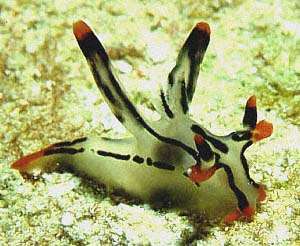
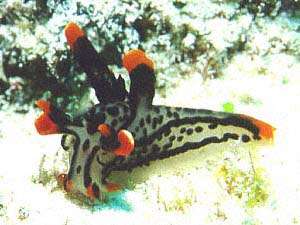
Thecacera picta
Baba, 1972
Order: NUDIBRANCHIA
Suborder: DORIDINA
Family: Polyceridae
Subfamily: Polycerinae
DISTRIBUTION
Originally recorded from Japan, and since from northwestern Australia. Records in the Forum from the Indian Ocean [Maldives] and various islands in tropical western Pacific.
PHOTO
UPPER: Ashmore Reef, Kimberley region, northwestern Australia. LOWER: Cartier Island, Kimberley region, northwestern Australia. PHOTOS: Clay Bryce.
These photos provided by Clay Bryce, Western Australian Museum to show the range of colour variation in Western Australia. See message below asking whether this shows that T. vittata is a synonym.
Reference:
• Baba, K. (1972). Thecacera picta spec. nov. from Suruga Bay, Japan (Nudibranchia: Doridoidea: Polyceridae). The Veliger, 15(2): 88-90
Rudman, W.B., 1998 (November 13) Thecacera picta Baba, 1972. [In] Sea Slug Forum. Australian Museum, Sydney. Available from http://www.seaslugforum.net/find/thecpict
Related messages
Black Thecacera picta from Philippines - 2
January 22, 2009
From: Marcel Tanke
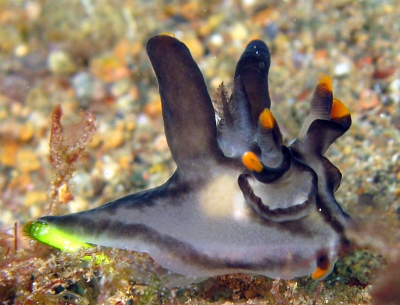
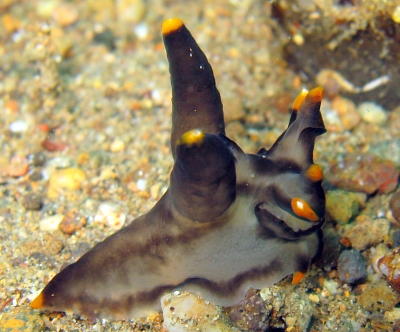
Concerning message #22026:
Dear Bill,
Within a few meters from each other, we found several gray and black Thecacera picta on the sandy bottom of Anilao Secret Bay dive site. I think this supports the link with the white T. picta, as per the previous message.
Locality: Anilao, 10 meters, Philippines, 1 January 2009, sandy, flat bottom . Length: 2 cm. Photographer: Marcel Tanke.
Best regards,
Marcel
marceltanke@cs.com
Tanke, M.A., 2009 (Jan 22) Black Thecacera picta from Philippines - 2. [Message in] Sea Slug Forum. Australian Museum, Sydney. Available from http://www.seaslugforum.net/find/22160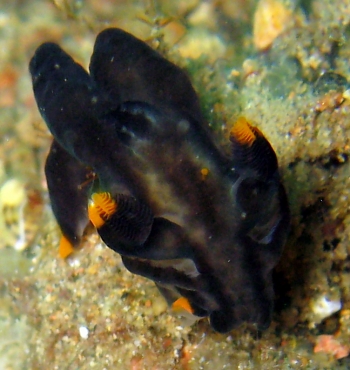
Thanks Marcel,
I think that we can be pretty certain that these are all one species
Best wishes,
Bill Rudman
Variation of Thecacera picta from Maldives
November 25, 2008
From: Marcel Tanke
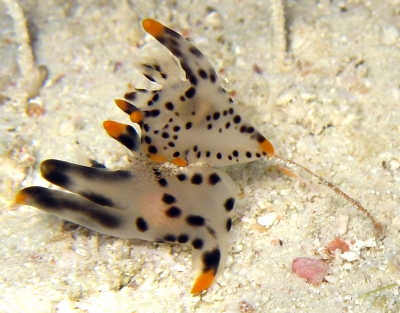
Concerning message #22026:
Hi Bill,
Here are two more Thecacera picta. I think they have again another colour pattern variation. We found them in a rather strong current. They were holding on to and maybe eating from, a small hydroid. It seems like the top one has white gills with a couple of relatively large black dots. The lower one has small red dotted gills, which you can see just in the middle between them.
15 m, Maldives, 26 December 2007, Sandy bottom. Length: 1 cm. Photographer: Marcel Tanke.
Best regards,
Marcel
Marceltanke@cs.com
Tanke, M.A., 2008 (Nov 25) Variation of Thecacera picta from Maldives. [Message in] Sea Slug Forum. Australian Museum, Sydney. Available from http://www.seaslugforum.net/find/22049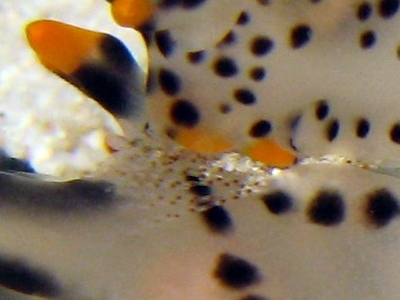
Dear Marcel,
Thanks for the interesting photo. The dotted 'gills' in the lower animal are in fact a branched bryozoan colony that this species eats [see messages #5771, #20058, #21602]. This colony seems to have quite a long stalk which the upper animal has crawled up and consequently bent over.
It interesting how many photos there are of tropical species of Thecacera crawling over what seems to be a wasteland of sand, apparently lacking any food. Photos like yours show that food, such as bryozoan colonies can be found wherever there is a small rock, or large shell fragment, for them to attach to.
Best wishes,
Bill Rudman
Black Thecacera from Philippines
November 13, 2008
From: Marcel Tanke
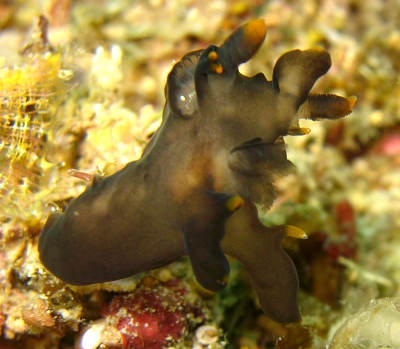
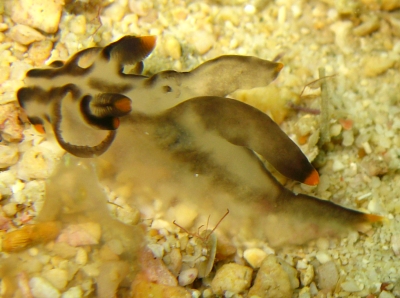
Concerning message #12845:
Dear Bill,
We found this black Thecacera in Puerto Galera, which looks like Thecacera sp. 3. About 1 meter from it were two 2 gray/white animals.
The black one here has several small additional appendages, abnormalities?
Locality: Puerto Galera, 15 m, Philippines, 10 February 2008, sandy bottom. Length: 1 cm. Photographer: Marcel Tanke
Best regards,
Marcel
Marceltanke@cs.com
Tanke, M.A., 2008 (Nov 13) Black Thecacera from Philippines. [Message in] Sea Slug Forum. Australian Museum, Sydney. Available from http://www.seaslugforum.net/find/22026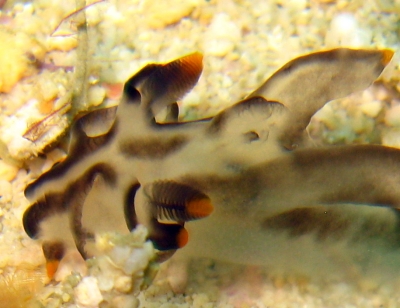
Dear Marcel,
Thanks for these photos. They solve the mystery of Thecacera sp. 3, as I am sure your greyish animals link the blackish one to the white Thecacera picta. Certainly the greyish ones are T. picta.
Concerning 'abnormal' appendages: the small orange-tipped papillae at the base of the large appendages by the gills are unusual, but the ones up near the rhinophores are sometimes found in T. picta. I am not sure about the large flap on the inside of the right rhinophore. It is possibly the sheath that usually surrounds the rhinophore club in this species. If it is, it is possibly misplaced through some damage or abnormality.
Best wishes,
Bill Rudman
Thecacera picta from Philippines
August 11, 2008
From: Marcel Tanke
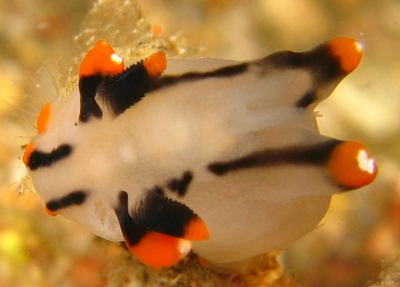
Hi Bill,
Attached are 2 pictures of a Thecacera picta we saw at Anilao, during a night dive. Please note that the right rhinophoral sheath seems to be in 2 parts. An abnormality?
Locality: Anilao, dive site Twin Rocks, 15 m, Philippines, 12 July 2008, Sandy bottom. Length: 1 cm. Photographer: Marcel Tanke.
Best regards,
Marcel
marceltanke@cs.com
Tanke, M.A., 2008 (Aug 11) Thecacera picta from Philippines. [Message in] Sea Slug Forum. Australian Museum, Sydney. Available from http://www.seaslugforum.net/find/21745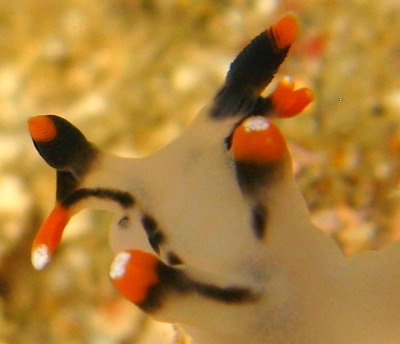
Thanks Marcel,
Yes the papilla on the outer edge of the right rhinophoral sheath is certainly split in two. Looking at other photos of this species and other species of the genus, this does indeed seem to be uncommon.
Best wishes,
Bill Rudman
Re: Feeding Thecacera picta from Vanuatu
June 6, 2008
From: Teresa Zuberbühler
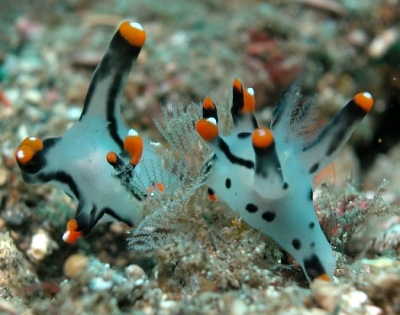
Concerning message #20058:
Dear Bill
Here another picture of Thecacera picta eating bryozoans. There were two of them, nearly fighting for their favorite food.
Locality: Lembeh, 15m, Sulawesi, Indonesia, Pacific, July 2004, sand and rubble with little coral cover. Length: 2.5cm. Photographer: Teresa (Zubi) Zuberbühler.
Teresa Zuberbühler
webmaster@starfish.ch
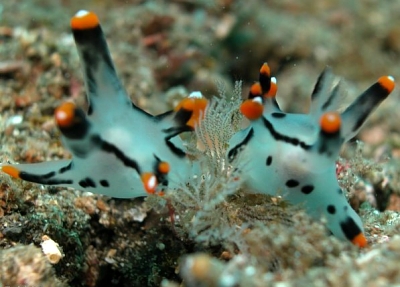
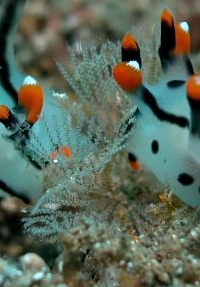
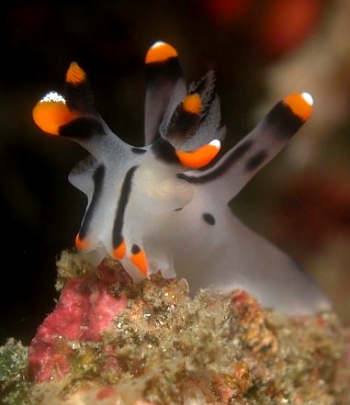
Thanks Zubi,
It is always good to get another record of a nudibranch feeding
Best wishes,
Bill Rudman
Thecacera picta from Mozambique
September 6, 2007
From: Valda Fraser
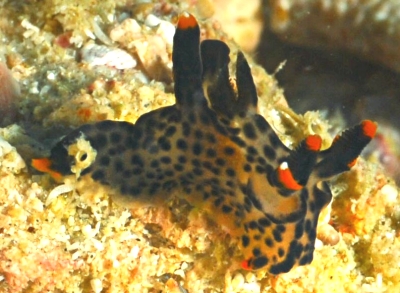
Dear Bill
Always great to find a nudibranch that I have never seen before. Think it is Thecacera picta. Links very closely in colouration to the image submitted from Australia on the Factsheet.
Locality: Pomene, 20 m, Mozambique, Indian, Reef. Length: 10 mm. Photographer: Valda Fraser.
Regards
Valda
valdafraser@mweb.co.za
Fraser, V.J., 2007 (Sep 6) Thecacera picta from Mozambique. [Message in] Sea Slug Forum. Australian Museum, Sydney. Available from http://www.seaslugforum.net/find/20632Dear Valda,
It's good to know you are still keeping an eye open for nudibranchs. Yes this is a heavily spotted form of T. picta.
Best wishes,
Bill Rudman
Re: Feeding Thecacera picta from Vanuatu
July 25, 2007
From: Kerem Turker
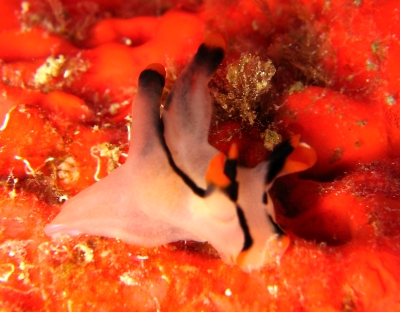
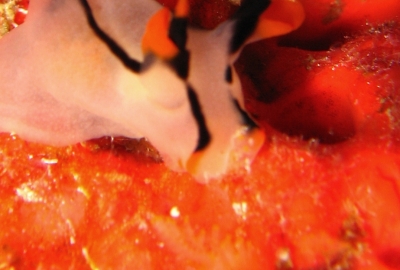
Concerning message #20058:
Dear Bill,
Here is another feeding information for Thecacera picta, Raja Ampat Indonesia. Within the same sponge there were 5-6 individuals feeding. They seemed to be enjoying the food. The strong current affected the quality of the pics as these guys are hard to find and focus as being "translucent clear".
Locality: Kri Island, Raja Ampat, 12 meters, Indonesia, Western Pacific , 20 March 2007, Reef wall . Length: About 1 cm. Photographer: Kerem Turker.
Regards,
Kerem
kerem.turker@pmintl.com
Turker, K., 2007 (Jul 25) Re: Feeding Thecacera picta from Vanuatu. [Message in] Sea Slug Forum. Australian Museum, Sydney. Available from http://www.seaslugforum.net/find/20177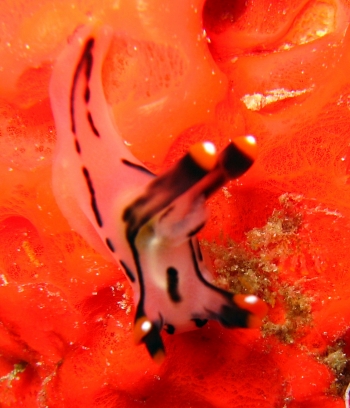
Dear Kerem,
It is not clear what your animals are eating. It won't be the sponge. In the middle photo I can see some 'plant-like' growths which may be bryozoan colonies, but its not clear enough to be certain
Best wishes,
Bill Rudman
Feeding Thecacera picta from Vanuatu
July 9, 2007
From: Barbara Hanchard
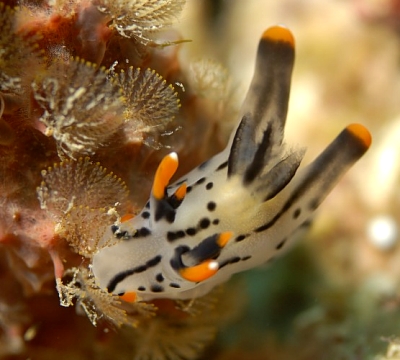
Concerning message #19706:
Bill,
The attached photo lends support to the idea [message #5771] that Thecacera picta feeds on aborescent bryozoans. This chap was happily munching away. Third occasion of sighting this species in the Solomon Islands for me.
Locality: Beside the "Wreck of the Ann" Russell Islands, 15 metres, Solomon Islands, Pacific Ocean, 16 June 2007, Sandy slope. Length: 25 - 30 mm. Photographer: N. Barbara Hanchard.
I have photos of the other two separate occassions of sighting in 2005 on Guadacanal but they are not feeding and photo quality predates current camera capabilities and skill.
Hope this of use to your database?
Regards
Barbara Hanchard
barbara.hanchard@ffa.int
Hanchard, N.B., 2007 (Jul 9) Feeding Thecacera picta from Vanuatu. [Message in] Sea Slug Forum. Australian Museum, Sydney. Available from http://www.seaslugforum.net/find/20058Dear Barbara,
The first thing I noticed when I opened your message was the animal apparently feeding on the bryozoan. With Erwin's observation [#5791] and yours, I think we can say its food is known. If we had prizes to offer, you would definitely win this weeks prize.
Best wishes,
Bill Rudman
Re: Thecacera picta from Vanuatu
April 3, 2007
From: Josh Jensen
Concerning message #19706:
It was quite awhile ago and I may have over estimated the size but I recall it being quite large, at least 50 mm for sure.
Josh
josh@underseaproductions.com
Jensen, J.P., 2007 (Apr 3) Re: Thecacera picta from Vanuatu. [Message in] Sea Slug Forum. Australian Museum, Sydney. Available from http://www.seaslugforum.net/find/19792Dear Josh,
Thanks for getting back to me. When I see a measurement which is far outside the norm, it's worth checking. I realise 'accurate' measurements from memory are not possible, so its worth knowing its an estimate.
Best wishes,
Bill Rudman
Thecacera picta from Vanuatu
March 30, 2007
From: Josh Jensen
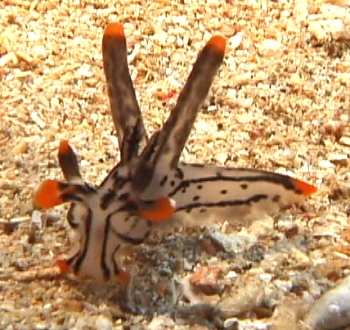
This slug was moving quickly over a sand and rubble bottom with scattered sea grass and coral bommies at night. It didn't stop to feed on anything while I was watching. The dive site was the President Coolidge wreck and the slug was near the safety stop area on the way up the steep slope so the depth info may be irrelevant as only 100 m either side could have the slug on the beach or at 60 m depth.
Locality: Near wreck, shore dive, 8m, Vanuatu, Western Pacific, 20 December 2004, Sand slope between beach and 60 m. Length: 70 mm. Photographer: Josh Jensen.
Josh Jensen
josh@underseaproductions.com
Jensen, J. P., 2007 (Mar 30) Thecacera picta from Vanuatu. [Message in] Sea Slug Forum. Australian Museum, Sydney. Available from http://www.seaslugforum.net/find/19706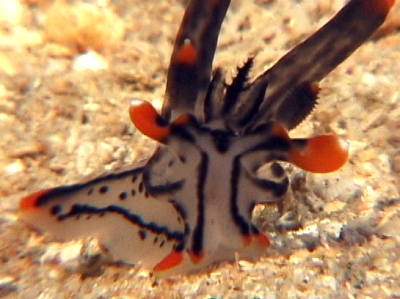
Dear Josh,
This is Thecacera picta. Could you confirm the length please? 70 mm is quite a bit larger than most specimens that have been reported. That is not to say you haven't found a very large specimen, but since 25 - 30 mm is the usual size, I think it is worth checking.
Best wishes,
Bill Rudman
Reddish Thecacera picta
January 24, 2006
From: Rokus Groeneveld
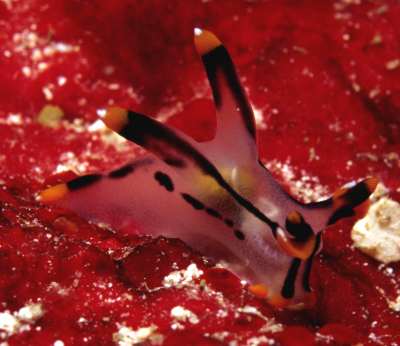
Daer Bill,
Today I was checking out some information about Thecacera picta. I noticed they are all more or less white. And because you write in one of your comments not very much is known about the colour variations I send you this picture.
The slug in this case is kind of red. It's not the reflection from the sponge it's on. But is it because it eats it, or an adaptation as camouflage?
Locality: Cabilao Island, Philippines, Visayan Sea. Depth: about 20 meters. Length: about 1 cm. 25 December 2005. wall. Photographer: Rokus Groeneveld
Best regards
Rokus Groeneveld,
Netherlands
rosa12@wxs.nl
Rokus G., 2006 (Jan 24) Reddish Thecacera picta. [Message in] Sea Slug Forum. Australian Museum, Sydney. Available from http://www.seaslugforum.net/find/15590Dear Rokus,
I am pretty sure the red colour is caused by the sponge it is sitting on. These animals are very watery with not much in the way of a thick muscular body wall, so when they don't have any pigment in their skin, we can see through them, very much like we can see shapes and colours through frosted glass. We can see a yellow-brown lump in the middle of the body, which is the digestive gland, and somw whitish bits in front, whcih are parts of the reproductive system and gut. The fact that we can see things inside the body like this shows just how transparent this species is. Since we can't see through it very clearly we say that it is 'translucent clear' rather than transparent. I guess being almost transparent like this is a good simple way to camouflage yourself. Of course not all nudibranchs are translucent or transparent, many such as the chromodorids are hightl coloured.
Best wishes,
Bill Rudman
Thecacera from Bali
December 31, 2004
From: Ian Dunsmore
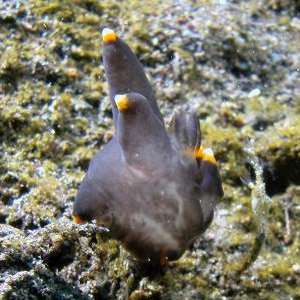
Note added 13 November 2008: This is a dark form of Thecacera picta. See message #22026.
Dear Bill,
These photos were taken in May 2004 in Seraya Bay, north Bali. I am assuming this is a relative of Thecacera sp. 2 on the Forum but have not come across many photos of this critter.
Locality: Seraya Bay, north Bali, Indonesia
Depth: 12-15m. Length: 20mm. 20 May 2004
Black sandy volcanic slope, shore dive.
Photographer: Ian Dunsmore
Hope these are of interest.
Best wishes,
Ian.
scubajock@moylan-diving.com
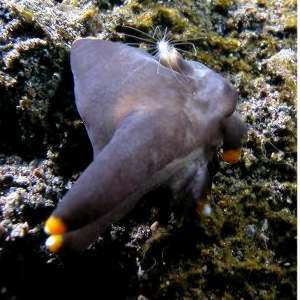
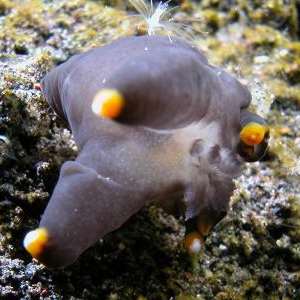
Dear Ian,
Thanks for this. If it weren't for the gills you can see in two of your photos I would have had my doubts about it being a nudibranch. I agree that it looks as though it is a Thecacera, but it is not a species I am familiar with.
Best wishes,
Bill Rudman
Thecacera picta from Indonesia
November 19, 2003
From: Ginette Allard
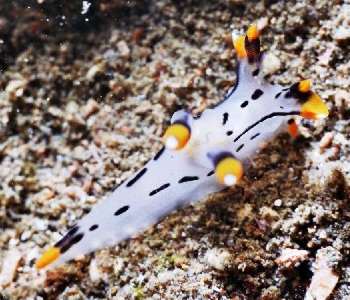
This is from Lembeh Strait, Indonesia.
Is it Thecacera picta ?
Thanks
Ginette Allard
ginette.allard@club-internet.fr
Allard, G., 2003 (Nov 19) Thecacera picta from Indonesia. [Message in] Sea Slug Forum. Australian Museum, Sydney. Available from http://www.seaslugforum.net/find/11353Dear Ginette,
It certainly looks like Thecacera picta.
Best wishes
Bill Rudman
Damaged Thecacera picta from Malaysia
May 20, 2003
From: Asther M. Lau
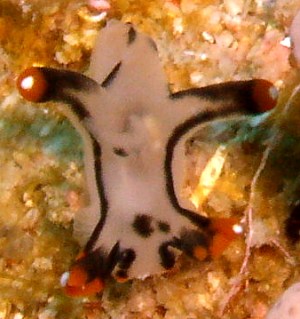
Hi,
Please help identify this species that I've found recently. is it Nembrotha???
Date: 27th April 2003
Location: Tanjung Api, Tenggol Is. Malaysia
Depth: 22m
Thanx,
Asther M. Lau
asther@scubadiveknit.com
Lau, A.M., 2003 (May 20) Damaged Thecacera picta from Malaysia. [Message in] Sea Slug Forum. Australian Museum, Sydney. Available from http://www.seaslugforum.net/find/9817Dear Asther,
This is damaged specimen of Thecacera picta. Something has bitten off its 'tail'. Nudibranchs are quite resilient, and unless something very vital is missing, they can survive damhge like this quite well, often regrowing the lost parts.
Best wishes,
Bill Rudman
Thecacera picta from Vanuatu
March 4, 2003
From: Vinka Stenhouse
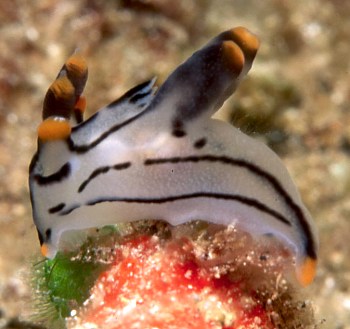
Bill,
This is another older image that I thought may be of interest. It was seen at a depth of 22m at Santo, Vanuatu in 1997.
Regards,
Vinka
vinkas@oceanaphotography.com
Stenhouse, V., 2003 (Mar 4) Thecacera picta from Vanuatu. [Message in] Sea Slug Forum. Australian Museum, Sydney. Available from http://www.seaslugforum.net/find/9196Thanks Vinka,
We now have records of Thecacera picta on the Forum from quite a few parts of the western Pacific and the Maldives in the Indian Ocean. I have updated the distribution details in the Fact Sheet to reflect this new information.
Best wishes
Bill Rudman
Re: Thecacera vittata from the Maldives
December 7, 2001
From: Erwin Köhler
Dear Bill,
Concerning your comment about the bryozoan. A pretty short time later the bryozoan colonies had disappeared - Thecacera picta feeds on it.
Erwin
Erwin@medslugs.de
Köhler, E., 2001 (Dec 7) Re: Thecacera vittata from the Maldives. [Message in] Sea Slug Forum. Australian Museum, Sydney. Available from http://www.seaslugforum.net/find/5791Thanks Erwin,
Every little bit of information is valuable but often we never hear of these observations because they are 'big' enough to justify publication in a scientific journal.
Bill Rudman.
Thecacera vittata from the Maldives
December 6, 2001
From: Erwin Köhler
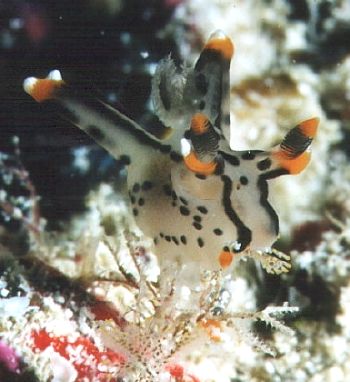
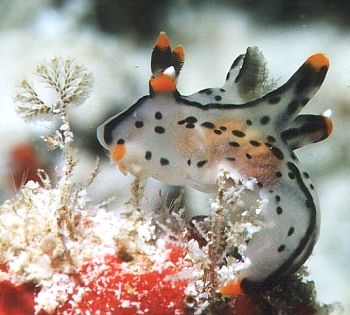
Dear Bill,
Attached are 2 shots from the Maldives, South Male Atoll, Vagali Island, divesite "Vagali Caves", length 24 mm, depth 16 m, 22 Sept. 2000.
I thought this one to be Thecacera picta, but today I read the description of Thecacera vittata by Nathalie Yonow, 1994 (Revue fr. Aquariol., 20, (1993): 4, 25 juillet 1994) and I think this is what she described. Is this species valid or is it just a variant of T. picta?
Erwin
Erwin@medslugs.de
Köhler, E., 2001 (Dec 6) Thecacera vittata from the Maldives. [Message in] Sea Slug Forum. Australian Museum, Sydney. Available from http://www.seaslugforum.net/find/5771Dear Erwin,
I sometimes wish the urge to describe new species wasn't quite as strong. Considering how little we knew about the colour variation of Thecacera picta, I would have thought that it was not a good idea for Nathalie Yonow to describe a new species on 2 colour slides. The main differences she notes between her species and T. picta were that T. picta had brown bands and not spots, and T. vittata had white markings and T. picta did not. Even from the photos we now have on the Forum you can see that both these characters are extremely variable. I am sure T. vittata is a synonym of T. picta.
I guess from the proximity of the bryozoan colonies, we can be reasonably confident that that is what it feeds on.
Best wishes,
Bill Rudman
Re: Thecacera picta - Three's a crowd
December 16, 2000
From: Mary Jane Adams
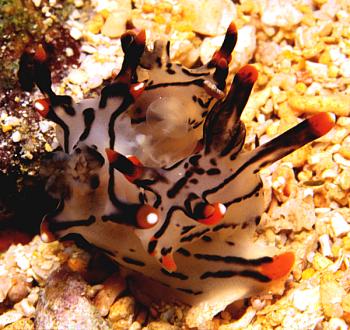
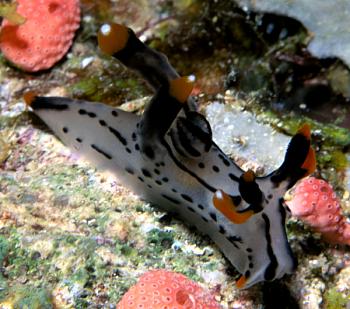
Hi Bill,
To add to Bruce Potter's message, every time I have visited the Solomon Islands over the last decade I have seen at least one Thecacera picta on the shallow reef or coral rubble surrounding the wreck of the Ann. This divesite is near the south end of Sunlight Passage in the Russell Island Group. I came across a trio of them in Nov., 2000 at a depth of 13 meters (Upper Photo). When I first saw them, the slug on the right was crawling toward the happily copulating couple. I shot this picture just as the intruder interrupted the action. After failing to join in, the scorned third party crawled away in defeat. The only other place I have seen Thecacera picta was once in Papua New Guinea. It was at about 20 meters on a coral reef on the south side of New Britain Island in Feb., 1995 (Lower Photo)
I hope this information is useful.
Best regards,
Mary Jane
divepng@yahoo.com
Adams, M.J., 2000 (Dec 16) Re: Thecacera picta - Three's a crowd. [Message in] Sea Slug Forum. Australian Museum, Sydney. Available from http://www.seaslugforum.net/find/3377Thanks Mary Jane,
Any information on these animals helps build a better understanding of ther distribution and biology.
Best wishes,
Bill Rudman.
Thecacera picta from the Solomon Ids
December 15, 2000
From: Bruce Potter
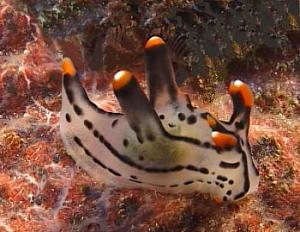
Dear Bill,
This is just another entry to extend your listed distribution range. I have found Thecacera picta in the Russell Islands, and the Florida Islands, and at Honiara. All in the Solomon Islands.
This particular one was at Bonegi 1 dive site near Honiara, found at about 20 meters.
Bruce Potter
bruce.potter@adventist.org.sb
Potter, B., 2000 (Dec 15) Thecacera picta from the Solomon Ids. [Message in] Sea Slug Forum. Australian Museum, Sydney. Available from http://www.seaslugforum.net/find/3375Thanks Bruce,
There is not much known about this species so photos showing colour variation and locality information are always welcome.
Best wishes,
Bill Rudman.
Thecacera picta from Great Barrier Reef
July 15, 1999
From: Jim Cruise
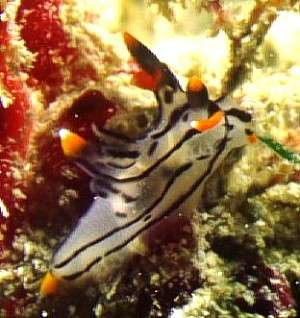
Dear Bill,
Here is the photo I promised of Thecacera picta from Queensland.
The details are: Hardy Reef Pontoon, Great Barrier Reef, 19 degrees 46'S, 149 deg 11' E., 36m, March 1995, 19mm long. PHOTO: Jim Cruise.
best wishes,
Jim Cruise.
jim.cruise@env.qld.gov.au
Cruise, J., 1999 (Jul 15) Thecacera picta from Great Barrier Reef. [Message in] Sea Slug Forum. Australian Museum, Sydney. Available from http://www.seaslugforum.net/find/1071Thanks Jim,
Bill Rudman.
Re: Thecacera picta from Great Barrier Reef
June 8, 1999
From: Jim Cruise
Confirming message from Jackie Sheils, that this species is common at Hardy reef (Whitsunday). I took several slides of one in about 1995. Richard Willan has a copy as he identified for me.
If you desire a copy let me know.
jim.cruise@env.qld.gov.au
Cruise, J., 1999 (Jun 8) Re: Thecacera picta from Great Barrier Reef. [Message in] Sea Slug Forum. Australian Museum, Sydney. Available from http://www.seaslugforum.net/find/930Dear Jim,
Thanks for the feedback on Thecacera picta. Yes I would very much like a copy of your photo from the Whitsundays.
Best wishes,
Bill Rudman.
Thecacera picta from Great Barrier Reef
May 3, 1999
From: Jacquie Sheils
Dear Bill,
Just a note to let you know that Thecacera picta is very common where I work at Hardy Reef, about 80km NE of the Whitsunday Islands.
We see them regularly at depths of about 20m on sand and rubble slopes at the edge of Hardy Reef. At times there appear to be aggregations of them converging on one area, no doubt for sexual purposes!
Jacquie Sheils
jsheils@mackay.net.au
Sheils, J., 1999 (May 3) Thecacera picta from Great Barrier Reef. [Message in] Sea Slug Forum. Australian Museum, Sydney. Available from http://www.seaslugforum.net/find/827Dear Jaquie,
I would love some photos of this animal from the Whitsundays as I don't know of any records of Thecacera picta from that region.
Concerning 'breeding' aggregations. There is a lot of debate about why we find aggregations of Sea Slugs. What we do know is that most mature Sea Slugs will mate, or attempt to when they meet. I guess this is a survival strategy for animals which can't see each other and may only cross paths infrequently. It is possible that in species with very specialised diets, aggregations occur because they are all attracted to a colony of their favourite, but perhaps, uncommon food.
Most Sea Slugs hatch as free-swimming veliger larvae which spend some time in the plankton before settling down on the bottom and growing into crawling slugs. In many cases, it appears that chemicals from their adult food trigger the larvae to stop swimming and to settle down. Having planktonic larvae ensures that, in most species, each generation is spread far and wide.
Some species however have what is called 'direct development' where the slug no longer has a free-swimming larval stage and hatches straight from its egg mass as a tiny crawling slug. In these species, the egg masses are often laid on, or very near, their food, which means that the young often start life in an aggregation and usually stay together until the food runs out. These species often grow very quickly, so unless observations are made very frequently, it may appear that a group of slugs has just 'moved in' when in fact they have always been there but have grown to visible size very quickly.
It's a bit difficult to make a guess at whether, or why, Thecacera aggregates. I suspect it feeds on a bryozoan (lace coral) colony but as with many Sea Slugs, until we know more about their basic natural history it's difficult to say anything sensible about them.
Any photos and/or observations on the feeding, breeding, egg-laying etc of Thecacera, or any Sea Slugs for that matter, would be very welcome.
Best wishes
Bill Rudman.
Colour variation in Thecacera picta
November 13, 1998
From: Clay Bryce
Dear Bill,
I thought these pictures [see top of page]of Thecacera picta from Western Australia may be of interest. Nathalie Yonow's species T. vittata seems to be a synonym falling within this colour range. I have other shots showing a range of pattern variation.
All the best,
Clay Bryce
Western Australian Museum
Perth,
WA, 6000.
brycec@museum.wa.gov.au
Bryce, C., 1998 (Nov 13) Colour variation in Thecacera picta. [Message in] Sea Slug Forum. Australian Museum, Sydney. Available from http://www.seaslugforum.net/find/302Thanks Clay,
Anyone got any comments? As with the discussion we are having about the range of colour variation in Thorunna florens , this is another example of how valuable it is to build up information about colour variation both within a geographic locality and throughout the range of a "species". .. Bill Rudman.
